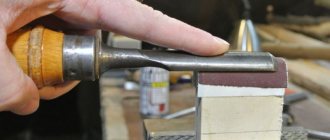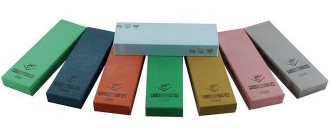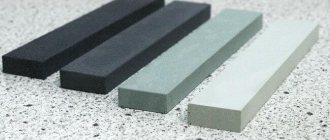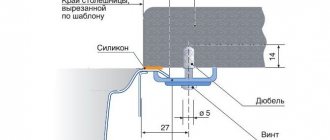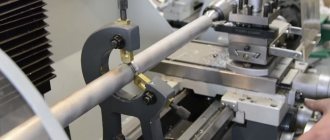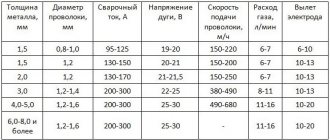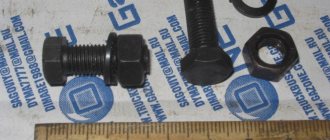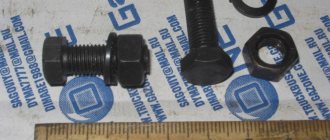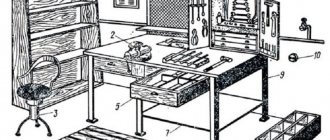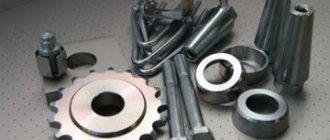How to care for whetstones
You need to care for sharpening stones taking into account their quality characteristics:
Water stones. They are stored in special vinyl boxes from which moisture does not evaporate. You can constantly keep such a stone in water
It is important not to let it freeze - it will probably burst and lose its properties. Any other stones. They are stored in a place where practically no dust collects, it is better to do this in a closed box
The fact is that dust clogs the space between the abrasive particles, and the sharpening stone becomes ineffective.
It is undesirable for the surface of the sharpening stone to come into contact with other surfaces, so if there is no separate packaging, it should be wrapped in paper or a textile napkin.
Sharpening stones are available on the market in a wide range. When choosing, you need to take into account many nuances - material of manufacture, grain size of the abrasive coating, size and shape. Most sharpening stones have a long service life if consumers comply with the conditions of use and care.
Natural stones
Arkansas stone is based on traditional crystalline silica, in other words, quartz. However, the structure of this material is special. Among the first characteristics, one can highlight the fact that this rock acts as the purest of all quartz rocks. Thus, it contains 99.5% SiO2. If we compare it with rock crystal, then even in it there are much more foreign inclusions. The second feature of Arkansas is expressed in the fact that it has a homogeneous rock with crystalline quartz: it has the finest grain size, so the grain size is equal to the limit of 1-6 microns. The last thing to pay attention to is the strength of the bonds between the factions, which are very strong. This is due to the implication structure, which is expressed by the fact that the jagged boundaries of the factions seem to be woven into each other. This material is very rare, the only place in the world where its deposit was found is in the Arkansas River basin, which flows in America. It was she who gave the name to the stone.
Figure 1. Grain table for Arkansas, Washita and India stones.
In ancient times, the rock lay in massive layers in the area, but eventually people began to carry out intensive mining, which made the deposits more scarce. Today, this material is in danger of being classified as precious stones. A comparison will help you understand how rare this material is. Even diamond is mined in several dozen places. The described rock, like Siberian charoite, may well disappear completely without a trace. With a coarser grain size of Arkansas, its porosity is greater, which indicates that the rock in this case does not have such significant hardness. It is represented by various varieties, among them: hard, medium, and soft; the rock lies in separate, often adjacent layers.
What is it like?
A diamond stone is a plate of a certain thickness with an aluminum base, on which a layer of synthetic diamond powder is applied. The latter is usually supplemented with a bakelite binder, its concentration varies from 25 to 100%. The spray layer is perfectly smooth. The crystals protrude strongly above the surface, but are firmly fixed on the block.
Venev diamond bars ensure the fastest possible removal of the metal layer from the surface being treated. They are used for sharpening and finishing polishing of any cutting tools - knives, axes, scissors, razors, chisels. The abrasive tool is ideal for straightening the cutting edge of all types of steel products, including high-alloy and tool ones. It is also suitable for sharpening ceramic knives. If we compare special devices and other abrasives, Venevsky bars have a larger number of cutting points and the distance between them on the working surface - which is why they are several steps ahead in terms of processing quality and the final result. One side can sharpen an average of 200 to 1000 knives, which is beyond the capabilities of similar products offered by other manufacturers.
Sharpening: principle and options
Sharpening a blade is the process of removing an edge with an abrasive along the entire length of the blade at a certain angle. The sharpening angle depends on the hardness of the steel and the tasks facing the blade. So for household kitchen and hunting knives the sharpening angle is 30...35 degrees, a hunting knife with resistance to dullness is sharpened at 40...45.
Blades that require special blade sharpness stand somewhat apart, usually chef knives or knives for professional food processing, in this case the sharpening angle is from 25 degrees.
Separately, it is worth considering the sharpening angles of razors and surgical instruments, since they require blade sharpness. For a straight razor, the sharpening angle is 14...15, for a surgical instrument - from 12 to 25 degrees.
Knives are sharpened by two methods: manually using abrasive bars or special devices and mechanically using a sharpening machine with a rotating abrasive wheel.
The first option requires skill, but at the same time it is easier to learn and accessible to everyone. Abrasive stones of various types are used for sharpening, the most common are:
- Arkansas, known as novaculitis;
- Japanese water stones;
- diamond bars;
- ceramics.
Each type of stone has its own advantages and disadvantages. These stones will be discussed separately below. To quickly sharpen kitchen knives, sharpeners with fixed or variable fastening of abrasive planes are often used, sharpening in which is carried out by moving the blade between sharpening surfaces.
Mechanical sharpening on a machine is much simpler, less time-consuming, but requires constant temperature control and compliance with safety regulations.
Important! When sharpening on a machine with electrocorundum abrasive, you need to control the temperature of the blade metal; if the blade steel overheats, it can change its physical properties.
Grit of sharpening stones
Even amateur sharpening on stones is not something simple, always successful the first time. Those who have never used such abrasives are faced with the first problem of “what stone to buy.” And the grain ratio is also important in this choice. Grit is grit (sometimes written “gridness”), this term from experts can often be heard regarding this characteristic of stones. The value of this parameter determines how aggressively the stone will act on the metal.
Description of the effect of grain size.
- Large grains inevitably leave deep gouges and chips on the metal surface, and no one wants that. Because ideally, after sharpening, a sharp and even edge should form, preferably a mirror edge, without any visible defects. Therefore, large grains can be used exclusively when working with blanks, for example, for a newly forged blade.
- Fine grains are used for metal grinding and finishing polishing. You will have to tinker with such a stone longer, but all for the sake of optimal results.
- Knives are sharpened with medium grain if the blade is slightly dull.
It turns out that ideally the set should contain 3 double-sided stones: with the finest grain, medium and coarse. A guide to your choice can also be a grain size table with classes from 1 to 14.
Sharpening technique
It’s quite difficult to tell in text how to sharpen a tool correctly, but I’ll try to do it.
The first thing I come across is the deep-rooted misconception that knives are sharpened by moving along the cutting edge, and this is absolutely not true. I can assume that the beginning of this misconception is to some extent related to the cinema, where some latter-day Rambo rubs a pebble along the blade.
In fact, the movements of the stone should be perpendicular to the blade, with the cutting edge forward
.
A novice sharpener should try to cut thin shavings from a stone with a knife, and the pressure on the knife should not be too great!
Strong pressure during sharpening does not in any way contribute to an increase in speed, but only aggravates the loss of flatness of the stone, or increases the speed of smoothing the grain (depending on the model of the stone) and the cutting edge itself due to high pressure. It begins to bend in the opposite direction, which subsequently complicates sharpening on the next stones.
The second extremely important and most difficult aspect is constant control of the sharpening angle.
. If with each new wire on the stone you have a new angle each time, or the knife swings during the wire itself, nothing useful will come of such sharpening. The main task is to develop motor skills to maintain the desired angle. How to do this? It’s very simple - sharpen and sharpen again, analyze, control - this is the only way to learn how to sharpen by hand.
To effectively maintain a cutting tool, you need to have at least three stones of different abrasive grain sizes:
F 230
.
This is a rough stone, with a large grain, designed for large steel removal if the knife has visible jams - chips. F 600
.
Main sharpening stone. Designed to remove rough marks after 230. Or if the tool is not seriously damaged, it is the first stone from which sharpening begins. F 1000
. Finishing stone. Its task, like all subsequent ones, is to completely remove the risks from the previous stone. And if F 1000 is the last stone in the set, then finish sharpening, giving the cutting edge the necessary characteristics.
This is a minimal set of sharpening stones and is not at all final. After F 1000 there can be 3000, 6000, 10000, 12000, 15000 and so on, it all depends on what degree of sharpness you want to achieve, taking into account how much it is justified for a certain steel.
How to use a whetstone for the perfect sharpening angle
The ideal sharpening angle for a knife on a block is also 25 degrees; this parameter does not change even when using several sharpening stones with different degrees of surface grain.
The algorithm of actions will be as follows:
- Take a block/stone with a coarse abrasive surface. If it is small, then it is clamped (fixed) in a vice.
- Place the knife blade against the surface of the sharpening device at an angle of 25 degrees and move it lengthwise towards you and away from you.
- Perform the same movement on the other side of the cutting edge. Continue the process until pronounced burrs appear on the metal.
- Change the block to a fine-grained one and carry out the same manipulations until even small burrs disappear.
It is believed that working independently on a block makes it possible to bring the knife blade to an almost ideal state of sharpness.
What it is?
A whetstone is a universal tool that is needed for both maintenance and repair of knives and razors, as well as other devices with a cutting edge. This is an ideal product for sharpening, since the intensity of processing and the pressure force are chosen by the person independently (this advantage has already been mentioned in the same comparison with electric machines). The small dimensions of the sharpening stones are also a convenient condition for use. Everyone faces the need to sharpen a knife. Even the most high-quality knife needs to be sharpened sooner or later. And doing it manually from all sides is more convenient - not everyone has a machine, and carrying it to where it is and where they can sharpen a knife with it is a troublesome task.
Peasants who sharpened their braids from time to time used whetstones called “oselki” for this purpose. But those simple sharpening stones were not as comfortable as modern ones: before use, they had to be soaked in water for a whole day. Actually, that’s where the name “water stone” comes from. Subsequently, the bars began to be produced, and their markings were already used in the USSR. On such a block there was a manufacturer's mark, the type of product, its dimensions and accuracy class, grain size, technical characteristics and, of course, the standard.
Level, sharpen, polish, clean – the functions of a whetstone can be different.
This is interesting: What you need to know about an inflatable jack based on an air cushion
Review of popular sharpening stones
The market offers a huge selection of Russian-made sharpening stones, which have a favorable price-quality ratio. The most popular are:
- Stones "Petrograd". A popular brand that produces tools of varying degrees of hardness made of silicon carbide. The grain size of all products complies with the Japanese JIS-2017 standard.
- Grinderman stones. The production was launched in St. Petersburg under the leadership of Andrei Petrov. The company is engaged in the production and sale of sharpening stones and means for their maintenance.
- "Gritalon". The brand is responsible for the production of synthetic abrasive stones for both manual and electric sharpeners. The base material is silicon carbide.
Among foreign manufacturers, the Metabo brand is especially popular, which produces hand-held electric and pneumatic tools, as well as high-quality CBN wheels for various needs.
Japanese water stones
In specialized centers there is a sufficient selection of Japanese sharpening stones from the following manufacturers:
- Suehiro;
- YOSHIKIN;
- Yaxell;
- Samura.
The products of the above companies have a high price, which starts at $60.
Arkansas stones
American-made bars have long been loved by Russian consumers. The most popular brands are:
- Dan's;
- Smith's;
- Lansky.
Sharpening stones are a necessary thing that should be in every home where they care about the safety of knives and other cutting tools. What type of sharpening stones do you prefer to use? Do you think modern ceramic materials are better than Japanese water bars? Write your opinion in the comment.
Artificial stones
Among sharpening stones in the general sense, one cannot fail to note abrasive artificial materials, which are also called whetstones. They mainly contain grains of electrocorundum, the latter of which is an extremely hard material based on aluminum oxide, which is designated Al2O3 in the table.
Figure 3. Table of the use of Japanese whetstones.
The base may also contain silicon carbide, the technical name of which is carborundum; While the chemical composition is represented by the designation SiC, the composition may also contain a binder material. The quality characteristics of the bar depend on the quality of the latter and the uniformity of the fractions. If you intend to sharpen a tool using an artificial abrasive stone, then you should use a lubricant, which can be water or a soap solution. Otherwise, the base will soon become contaminated with steel dust. In Fig. 2 you can see artificial sharpening stones made on the basis of silicon carbide with the addition of a ceramic binder.
Sandpaper grit
Table of sandpaper standards: markings and grit
| GOST R 52381-2005 (Russia) | Grain size (µm) | Purpose |
| Coarse-grained | ||
| P22 | 800-1000 | Roughing |
| P24 | 630-800 | |
| P36 | 500-630 | |
| P40 | 400-500 | Rough woodwork |
| P46 | 315-400 | |
| P60 | 250-315 | |
| P80 | 200-250 | Primary grinding Surface smoothing Removing small irregularities |
| P90 | 160-200 | |
| P100 | 125-160 | |
| P120 | 100-125 | |
| P150 | 80-100 | Preparing hard wood for sanding Final sanding of soft wood Sanding old paint for painting |
| P180 | 63-80 | |
| Fine-grained | ||
| P240 | 50-63 | Final sanding of hardwood Sanding between coats |
| P280 | 40-50 | |
| P400 | 28-40 | Polishing final coats Sanding before painting Wet sanding |
| P600 | 20-28 | |
| P1000 | 14-20 | Grinding of metal, plastics, ceramics Wet grinding |
| P1200 | 10-14 | Even finer grinding, polishing Removing gloss, stains, micro-scratches |
| P1500 | 7-10 | |
| P2000 | 5-7 | |
| P2500 | 3-5 |
What is the grit of a whetstone?
This characteristic shows how many abrasive grains are contained in 1 square meter. see work surface. Grit is measured in grit and varies from 80 to 10,000. The lower the grit, the larger the abrasive particles. Coarse-grained whetstones are used for initial, rough sharpening of the blade. They remove metal deeply, changing the shape of the blade very quickly. Such bars are used to restore severely dull or damaged cutting edges.
Abrasives with high grit are used for finishing the blade. They remove a very thin layer of metal with each pass, reducing the risk of scoring or other edge damage.
Professionals use sets of whetstones of different grain sizes, gradually moving from coarse to fine, and bring the blade to a high sharpness and the correct sharpening angle. This multi-stage sharpening lasts for a very long time, since the metal layer is perfectly aligned.
Several grain gradation systems are used around the world:
- FEPA-F - the system was developed in the European Union and is also used in America;
- JIS Japanese system;
- GOST 9206-80 – for diamond abrasive materials;
- GOST 3647-80 – for other abrasive materials.
The system values do not match, but transition tables exist.
Stones for sharpening knives: the best by manufacturer
The best manufacturers of stones for sharpening knives are considered to be Russia, Japan, China and the USA; Soviet-made tools can still be found on sale, and many professionals prefer them.
Russian made: Petrograd, Grinderman, Gritalon
Sharpening stones, which are produced in Russia, are distinguished by the correct price-quality ratio.
Of the most popular, it is worth highlighting:
Title Description Photo “Petrograd”
This brand produces silicon carbide stones that are distinguished by a variety of surface hardness. It is important that the degree of graining exactly corresponds to Japanese standards - they are recognized throughout the world as the best.
“Grinderman” Production is located in St. Petersburg, the company not only produces various sharpening tools, but also provides full service.
“Gritalon” produces synthetic abrasive tools that can be used both for sharpening machines and for manual work. The material used in production is silicon carbide.
Japanese: Suehiro, YOSHIKIN, Yaxell, Samura
Sharpening stones made in Japan are usually used for manual work and with water; the most famous brands of such tools are:
- Suehiro;
- Yoshikin;
- Yaxell;
- Samura
The difference between such stones is that when sharpening cutting surfaces, new layers of abrasive are constantly “opened”, and particles of the previous ones are mixed with water and have the best possible effect on the blade.
The Japanese produce sharpening stones with different degrees of grain, so when using a tool with fine grains at the last stage, it makes it possible to bring the cutting surface to perfect condition without the additional use of pastes, felt and dressing slings.
Japanese water stones are distinguished by the highest productivity, which can only be compared with diamond tools. But the latter increases the risk of excessive thinning of the blade at the final stage of finishing the cutting surface.
Japanese whetstone grit standards are recognized by international organizations and are used for designation by most manufacturers.
Soviet
Soviet sharpening stones are bars of absolutely regular shape, onto which a coating of abrasive material (base – silicon) was applied. You can still find Soviet sharpening stones and whetstones on sale at flea markets - they are considered high quality and “eternal.”
On the territory of the USSR, they used their own, individual markings, which are radically different from modern ones.
What was indicated on each product:
- dimensions;
- accuracy class;
- manufacturer (each had its own mark);
- dimensions;
- hardness level;
- structure characteristics;
- product type;
- material used in manufacturing;
- grain level.
Microcorundum block for straightening USSR razors, 1970
Chinese: Ganzo
Chinese sharpening tools include silicon carbide and aluminum oxide stones, which are characterized by fairly high quality, long service life and low cost. The most famous manufacturer is Ganzo. Such tools are especially good for sharpening ordinary kitchen knives - their grit level does not exceed 1000 grit, which allows you to bring the blade to the desired sharpness with one whetstone.
Recently, sharpening stones from China made of vacuum ceramics and boron carbide have appeared on the market. They have an almost eternal service life; even with prolonged sharpening of the tool, they do not wear out.
Chinese sharpening tool Ganzo
Arkansas: Dan's, Smith's, Lansky
Three companies stand out from the manufacturers:
- Dan's;
- Smith's;
- Lansky
Arkansas is a state in America where abrasive material is mined and grindstones are produced. Mineral reserves in this part of the country are already greatly depleted, so the cost of the tool is very high even by the standards of the Americans themselves. However, Arkansas stones have always been popular and are now considered the best quality on the market.
Sharpening household tools
To sharpen kitchen or woodworking tools, it is most practical to purchase a double-sided sharpening stone: large/medium or medium/fine (size of abrasive crystals). Natural stones are not taken into account, since they require a certain skill.
For the above purposes, diamond stones for sharpening knives produced by the Venev plant are quite suitable. The domestic enterprise, located in the Tula region, is a monopolist in the field of diamond tools on the Russian market.
Some Venev bars exhibit a manufacturing defect - problems with flatness. This deficiency is not critical and can be corrected. To sharpen any tool, you need to secure a block or stone on a flat surface, since you will need both hands when working.
The fasteners can be factory-made or ordinary planks nailed to the workbench as a stop. When sharpening a knife, you need to grab the handle with your right hand and the blade with your left (for right-handers) and try to use the entire surface of the stone for even chipping.
Place the tool with the butt towards you and the blade away from you, placing it on a stone. Sharpening is done by moving the stone away from you and slightly to the right, sharpening the left side. To sharpen the right side, the handle is taken in the left hand.
Both sides are sharpened the same number of times. Do not change the angle of the blade in relation to the block, otherwise the cutting edge will quickly become dull.
You need to grind until metal dust forms, check the sharpness on a sheet of paper - the knife should cut the paper freely with minimal effort. If the result is the opposite, you need to repeat the procedure. You can wash off abrasive particles from the knife and stone after work or during the sharpening process.
Sharpening scissors is easier and faster than sharpening knives. When you need to quickly sharpen scissors for several uses, you need to take a glass bottle or any cylindrical metal object (a needle will do).
Next, this equipment needs to be cut with scissors - literally. That is, make cutting movements across a metal object or along the neck of a glass bottle. This sharpening gives sharpness for a short period.
For best results, you need medium sandpaper, a file or a fine-grit sharpening stone. When using abrasive sandpaper, you simply need to cut it or rub it with scissors on the blade with the outer chamfers (cutting plane).
The internal parts of the blades cannot be sharpened - this can lead to complete malfunction of the tool. When using a file, you need to sharpen from the joint of the blades to the tip, running it along the outer edge of the blade.
When using a small whetstone, you can also work as with a file, and when using a large one, put scissors on it and also sharpen the outer cutting edge.
When sharpening, be sure to observe the angle; if it decreases or increases, either the wear of the blade will increase or the cutting ability will decrease. It is not recommended to check the sharpness of the tool using your own body parts.
So, some citizens test the sharpness of a knife by cutting off the hairs on their hand. The paper method is much safer. An abrasive corundum stone of medium/fine grain size is suitable for sharpening a meat grinder knife.
It is necessary to sharpen in a circular motion clockwise; together with the knife, the grate is also sharpened in the same way. During work, it is necessary to constantly wet the surfaces and carefully monitor the planes of the knives to prevent distortions.
When the cutting planes are sharpened to a shine, you should apply the knife to the grate and check for gaps between them - there should not be any.
Modern human life is accompanied by a variety of metal tools, which, in turn, require attention and care. To this day, for 5,000 years, sharpening stones and stones have been coping with this task, the demand for which is only increasing every year.
Artificial products
With the development of technology, sharpening stones for knives began to be made in industrial settings. This made it possible to reduce their price, however, their quality level is still not as high as that of natural materials. The only exceptions are artificial stones of the water type.
Artificial bars consist of two materials that are carefully mixed and bonded through high temperatures and pressure. The working particles are crystals of silicon carbite, which have sharp corners, grains of chromium oxide and corundum. These stones are much stronger than steel, and upon contact with a knife, they cut off a thin layer of metal.
How to make a whetstone with your own hands
You can make your own whetstone from ceramic tiles or silicon carbide and epoxy glue, but first you need to prepare a template and then follow the instructions.
From ceramic tiles
You need to take a fragment of ceramic tile measuring 30x8 cm; if there are mortar residues on the back side, then they must be removed. The relief side of the ceramic tile is ground down on a grinding wheel or sand-lime brick by active friction. During this process, fine abrasive dust will be formed - it must be removed periodically. You can bring the surface completely smooth with regular sandpaper.
As soon as the back side of the ceramic tile becomes smooth, the remaining abrasive particles are removed/washed off and completely dried. The whetstone is ready, you can use it to sharpen your kitchen knives, but you will definitely have to sharpen them until they are impeccably sharp and smooth.
Watch the video on how to make a whetstone for finishing a knife from ceramic tiles:
Made of silicon carbide powder and epoxy glue
You need to purchase 100 g of silicon carbide powder, prepare a wooden board with cuts on one side to fix the abrasive bar, and epoxy glue. For ease of work, you should wear medical gloves and use syringes.
Execution order:
- Mix 6 cubes of resin and 1.2 ml of glue (epoxy glue preparation kit) in a bowl.
- Mix thoroughly and add a little abrasive powder.
- Stir again and add silicon carbide powder again - this must be done until the dry material runs out.
Next, you need to prepare a cardboard box of the desired shape (a rectangular or square block is needed) and pour the prepared adhesive mixture into it. Cover the top with a board, sawn side down, and press down with a weight.
After 3-4 days, the glue will completely harden - and the block is ready for use. You will need to clean its edges and trim it with a file. To make the surface abrasive, you need to drop water on it and rub the frozen surface with a piece of glass with a small amount of sand.
Homemade sharpening stone for knives is ready
Such homemade sharpening stones do not have a long service life, but can be useful in force majeure circumstances.
How to properly sharpen knives with a whetstone
The main thing in sharpening a knife is to understand the sharpening technique
, because a master can sharpen a blade on an ordinary brick, but an amateur can ruin a blade even on a natural abrasive stone.
Before you start sharpening, prepare the following:
- Comfortable and non-slip working surface.
- Small bowl of water.
- Towel.
- Paper.
The first step is to prepare the knife: wash it with soap and dry it.
Then you need to decide on the sharpening product. alternate between coarse-grained and fine-grained bars while working.
. The ideal option would be to prepare coarse-grained, medium-grained and fine-grained stone. Using a coarse rectangle, the desired angle and shape of the blade edge is restored. Medium-grain stone restores the edge itself, and fine-grained stone is used for finishing. Different manufacturers have different degrees of granularity of fine-grained stone, so you need to choose such a stone as needed. It is best for a beginner to purchase a stone with a large working surface; the chances of properly sharpening a knife on it are much higher.
Before you start sharpening, you should put the bars in a container with water. If you choose a diamond stone, then it should be slightly wetted, but when you decide to use an Arkansas stone, you should not forget that it is coated with a special oil and not soaked.
After the necessary procedures, you need to select the sharpening angle
. The greater the angle of inclination during sharpening, the more different the purpose of the knife is. A blade sharpened at an angle of 30 degrees will find good use in complex work, sharpening at 20 degrees is suitable for work of medium complexity, sharpening at 15 degrees is suitable for light work. For a regular kitchen knife, the sharpening angle is just 15-20 degrees. If at first it is difficult to maintain the desired degree of sharpening, there are special pads with which you can maintain the desired degree.
Once you have decided on an angle, you need to stick to that angle throughout the entire sharpening process. Sharpening process
consists of the following steps:
- Grinding.
- Polishing.
- Finishing.
- Edge straightening.
A sharpening stone is placed on the table, which is removed from a container of water; usually there is a special stand under it, in order not to damage the surface of the table and to fix the stone on the surface. You need to take the knife with both hands: hold the blade with your left hand, and the handle of the knife with your right hand. Then you should select the desired angle relative to the working surface of the bar.
The edge of the knife should be facing away from you. Then move the blade along the block in a smooth motion away from you forward and to the right.
In the place where the blade bends, you should raise the handle of the knife so that the specified angle remains in the same position. Move the edge of the knife as if you want to cut an even thin layer from this rectangle
It is important to calculate the movement so that the beginning of the movement comes from the handle, the middle of the blade is in the middle of the block, and the tip of the knife blade remains at the end of the whetstone. Do not change the angle while sharpening your knife to make your job as efficient as possible.
Each side of the blade must go over the sharpener the same number of times, so switch sides of the blade after each pass over it.
You need to repeat the movements until small particles of metal appear over the entire area of the blade, and in the place where you ran the edge along the block, there should be an even shiny strip. Then remove the metal particles using paper and change the stone to a finer grit. Repeat the same steps. When it comes to the finest grain, you will need to grind the surface until a line appears on the opposite side, this is called a burr.
After increasing the gradation of the bar to fine-grain, the burr becomes smaller, but does not disappear. Therefore, you will need to get rid of it
, taking a stone with the finest grain and passing the blade along it with each side once, just like when sharpening, only the last movements should be done so as to almost not touch the surface of the sharpening product with the blade. For this procedure, it is best to take a clean bar or clean the used one in the manner described above.
The quality of a sharpened blade depends on how sharp the edge itself is. After you have gotten rid of the burr, you should take a special block of wood, treated with a special paste and leather, to polish the edge of the knife with it.
To check the sharpness of your knife, take a knife and a piece of paper.
. If the knife is able to cut paper without effort, then the knife was sharpened at an excellent level. Do not check the sharpness of the knife with your fingers, as this may cause cuts.
GOST
GOST regulates abrasive standards in the Russian Federation and some countries of the former USSR. All GOST standards are freely available.
Current standards governing grain size:
- GOST 9206-80 for diamond abrasives
- GOST 3647-80 for non-diamond abrasives
GOST calls macrogrits grinding grain and grinding powder, microgrits - microgrinding powder.
GOST 9206-80 (for diamonds) uses an intuitive naming of grain sizes - it indicates the range of the main fraction. But there is a catch in this, since there is also an adjacent and limiting fraction (therefore, 2/1 diamond powder can include grains from 0 to 3 microns.)
One of the charming features of the GOST 9206-80 classification is a simple system of ranges for all fractions: main, adjacent and marginal. You just need to remember the micron ladder - the sequence 1 - 2 - 3 - 5 - 7 - 10 - 14 - 20 - 28 - 40 - 60 for microgrits, and similar for macrogrits. The adjacent pair of numbers will be the main fraction for the same grain size (for example, 7/5 is the main fraction from 5 to 7 microns). The adjacent fraction is one step down (from 3 to 5 microns). The limiting fraction is one more step down and one step up (from 7 to 10 microns, plus from 2 to 3 microns).
For macrogrits, the adjacent fraction is one step up and down. (There is no fraction limit.)
GOST 9206-80 also has a classification of submicron fractions, but we will not touch on it due to its small use.
If you compare the size of strips of the main fraction GOST 9206-80 with FEPA and JIS, you will notice their relatively large size. But don’t criticize the Soviet standard
Unlike FEPA and JIS, the main fraction of GOST is from 70% to 80% of average grains (unlike 50% in FEPA, JIS and even GOST 3647-80).
GOST 3647-80 (for non-diamonds) uses almost the same micron ladder, but a different naming system. For macrogrits, grain size is indicated by a number, for microgrits - by a number with the index “M”. At the same time, the developers of the standard “fused” macrogrits and microgrits in a unique way: grain size 5 = M63, grain size 4 = M50 (they are completely equivalent except for the upper limit fraction).
Which sharpening stone to choose for kitchen knives
For kitchen knives, it is better to choose a water sharpening stone - they “work” faster and allow you to straighten the cutting surface without changing tools until you get the desired result. But you need to remember that some knife materials can rust when in contact with water, which will hopelessly ruin your kitchen tool. In this case, it is better to use oil sharpening stones - sharpening takes a long time, but it is always of high quality, and the blade of the knives does not rust.
As for the grit level of the whetstone, 1500 grit is sufficient for kitchen knives, because 240 grit is too coarse an abrasive surface that greatly thins the knife blade.
Nuances of choice
The main question of choice is what the stone is needed for, that is, you need to proceed from the main functionality of the product.
Tips for choosing.
- For kitchen knives, it is better to choose a water stone, since it works faster and you can straighten the cutting element without any problems. True, not all materials can come into contact with water; there is a risk of rust. If so, then oil-based models are suitable; sharpening takes longer, but this will not detract from the quality. Grit for kitchen knives is 1500, and, for example, 240 is an unacceptably low value, very rough for these purposes.
- You also need to decide on the abrasive material. Ceramics are increasingly being used in everyday life; the shape is a boat-shaped bar. The most common option was a double-sided stone with a smooth and rough surface. But diamond stones for kitchen knives are considered a luxury.
- The size of the block is also important; it should be two or at least one and a half times the length of the blade.
Sharpening stones are needed not only for knives and other kitchen tools, they are also used for sharpening attachments for drills, screwdrivers, grinders, meat grinders, cutters, and chains. Usually, by the markings you can understand what this stone will be used for.
Classification of whetstones
Sharpening stones have been used by humans for a long time. To restore the cutting properties of the scythe, peasants used special bars called whetstones. The simplest sharpening stones, which were known to our grandparents, were not very convenient to use: to obtain the required sharpness, the block was soaked in water for a day before use. For this they were called “water stones.”
Sharpening tool markings began to be used in the USSR. This was a forced step related to the standardization of products produced in the territory of the union. The following information was located on the sharpening stones of that time:
- manufacturer's marks;
- product type;
- dimensions;
- the material used and its grain size;
- technical characteristics (hardness, structure, mass fraction of the main fraction);
- accuracy class;
- interstate standard.
According to the type of origin, all sharpening stones are divided into two groups:
- natural;
- artificial.
Let's take a closer look at them.
Natural stones
- Arkansas. The name was given in honor of the deposit located on the territory of the state of the same name. It is a compound of quartz and rocks. The sizes of the main fractions and their characteristics may vary. There are three strength classes: soft, medium and hard. They are mined from different layers. It should be noted that due to the intensive development of the sites, the reserves of the material are greatly depleted.
- Japanese water stone. One of the highest quality types. It is mined in several regions of the country. Due to government restrictions on production volumes, such a tool will cost much more than similar devices.
Synthetic stones
- Diamond. Diamond chips, the structure of which has sharp cutting edges, are used as one of the components. Due to its high strength, the thickness of the working layer does not exceed a hundredth of a millimeter, which is quite enough for a long service life.
- Ceramic. Sharpening stones made using advanced technology. The product allows you to perform work with the quality of the best samples of natural stones, and the useful life is comparable to diamond bars.
- Aquatic. Industrial analogue of natural stones. Before use, it is necessary to soak in water in order to improve performance and protect the surface from clogging.
South African sharpening stones Zulu Gray
These stones get their name from the area where they are mined in the Kwa Zulu-Natal province. Despite the excellent quality characteristics, these stones are not so common among domestic sharpeners, because they do not have a centuries-old history, in addition, the material has a very high cost, these factors do not contribute to their rapid spread.
For a razor, it is recommended to finish the working surface of the stone and the sides without fail. When used, such stones do not release a suspension, but if you use another one, then perhaps it will appear. In work, such material shows itself quite well. Some craftsmen pre-soak in order to achieve more comfortable work. This is usually done for about half an hour or a little more, but when such procedures are carried out with the described stone, no particular difference is noted.
Table of grain size markings according to various standards.
The material works perfectly both with soapy water and with water that does not have additives. With a wide approach towards the end of the work and the use of water, the razor begins to stick somewhat.
Oil is often used in tandem with Arkansas. If you use the described material with it, the result will be excellent. First you have to drop the oil, rubbing it, you can get rid of the excess amount with a napkin. Craftsmen note good and pleasant tactile sensations; the material feels like velvet to the touch. Regardless of which razors are used, the sharpening surface performs well with all of them.
Experts who use Zulu Gray stones for sharpening note that the tool cuts freely and meets all sharpness requirements.
If you intend to sharpen a razor using such a stone, then to complete the finishing you need to slightly raise the angle, and you need to make about 30-50 passes for each side of the tool, applying such pressure that does not exceed the weight of the razor.
Experts note that they do not use razors that have undergone restoration, however, when testing the described stone and testing razors from various manufacturers, the results turned out to be good and indicative.
Methods of sharpening on water stones.
Some argue that South African stones can be considered the leaders in finishing among all others, including when compared with Coticule and Guangxi and Thuringian slate. It is recommended to use oil, but water works just as well as a lubricant. The only disadvantage in this case is the price, but if you operate it very carefully and for your own needs, then it will prove to be very economical. It also does a good job of producing extremely hard blades that some other stones cannot handle. The grain size of the stone is sufficient for this type of work.
Before purchasing a sharpening surface of natural or artificial origin, you should decide for what purpose and with what intensity you will use it.
If you have not previously had experience working with stones intended for turning, and subsequently plan to use them less often, then it is preferable not to purchase expensive material, but to use the help of a specialist.
Factors to consider when choosing a stone:
- area of use;
- intensity of application;
- grain.
How to choose
The diamond block is selected in accordance with the assigned tasks. It is necessary to understand the tasks ahead.
If you are working on a cutting edge restoration or reworking a factory angle, you will need 400/351 or 500/400 for the initial stage. It is clear that the initial treatment will depend on the wear of the knife. Then the editing is done according to the grain reduction scale: 160/125, 80/63 and finally - 7/5 will bring it to the razor.
Markings and symbols
The production of sharpening stones is subject to GOST 9206-81 for diamonds. All markings of diamond bars are divided into four categories:
| Category: | 1 | 2 | 3 | 4 |
| Grain: | 2500/2000; 2000/1600; 600/1250; 1250/1000; 1000/80; 800/630; 630/500; 500/400; 400/351; 315/250; 250/200; 200/160; 160/125. | 125/100; 100/80; 80/63; 63/50; 50/40. | 40/28; 28/20; 20/14; 14/10. | 10/7; 7/5; 5/3; 3/2; 1/0. |
The breakdown of grain size values is as follows. Example: 500/400 means the diamond granule size is in the range of 500-400 microns. The smaller the abrasive grain, the smaller the permissible range of values.
An example of stones with different markings.
A double-sided diamond stone is marked like this: “160/125 - 50/40.” Decoding the category table looks easy:
- Restoring and changing the shape of the knife and cutting edge. Such work is classified as repair work. Deep nicks, chips, burrs and other troubles.
- They will help you acquire the necessary parameters for the blade. Remove traces of roughing work with previous diamond stones.
- Finishing and finishing sharpening.
- Surface polishing and cutting edge correction.
The list items correspond to the category number in the table. If you cannot find a coarse-grained diamond stone for grinding work, it is not forbidden to use a stone with a smaller grain. But it is necessary to take into account that passes will have to be made more times. As a result, the abrasion of the diamond coating will occur more intensely.
Main criteria when choosing a stone
- small;
- average;
- large.
Coarse grain is used primarily to eliminate chips on the cutting surface due to the intensive removal of the damaged metal layer.
Then you should decide on the origin of the material. In terms of their technical characteristics, synthetic instruments are superior to natural ones. This statement is true for the average price category
To purchase a high-quality sharpening device, it is better to pay attention to Japanese-made products
Select your area of use. For sharpening home knives, dimensions do not matter, but on a long hike, the extra weight will definitely be of no use.
Varieties
The whetstones are divided into several types depending on the galvanic bond, which can be soft or hard. Each of them has distinctive properties and is suitable for certain jobs. The service life of products may also vary.
On a soft organic bond
Venevsky whetstones with a soft organic bond are a new product that is widely used for sharpening steel blades. For handmade we produce blocks of the following sizes (mm):
- 200 x 83 x 10;
- 120 x 35 x 10;
- 200 x 35 x 10.
To use a block in a sharpener, it must first be sawn. Products for machine tools with dimensions of 150 x 25 mm have already appeared on the modern market. When purchasing such an assistant, the need for sawing is eliminated.
The bars have a soft organic base and are characterized by the presence of a uniform coating, the thickness of which is at least 3 mm. This is a high-quality abrasive that provides effective sharpening. In terms of their properties, the products are very similar to standard stones intended for the same purposes. Diamond crystals protrude slightly above the surface; they are directly embedded in the soft binder. Compared to galvanic-based bars, where diamond chips are simply interspersed, such varieties work more gently with metal. The risks remain shallow. In addition to the fast and efficient operation of the device, it is also easy to level. During the sharpening process, the properties of the consumable tool are observed to be preserved for a long time; according to user reviews, up to 5 years.
On a solid galvanic bond
Bars with a solid galvanic bond have a more rigid structure. The production material is ferromagnetic, so the use of products on sharpeners with magnets is not recommended. The use of bars is allowed if the blade is fixed manually on the sharpener table.
The crystals do not need to be aligned; after purchasing a sharpener, you can immediately use it for work. The use of Venev devices is recommended to replace the most expensive abrasives when sharpening simple knives at home. The whetstones have high productivity, which ensures quick and comfortable sharpening of the blade. They are characterized by long service life and abrasion resistance. If the efficiency of the device decreases, it is recommended to soak it in an acid solution.
There are several disadvantages to this type of block. If the device is bent, it can only be straightened by bending the plate on which the coating is applied. During operation, there is a gradual actuation of fragments, as well as their falling out of the bundle, which leads to a loss of the initial effectiveness of the tool. Crystals may protrude unevenly above the surface if improperly manufactured or during operation. If individual particles are released, they will leave deep cuts on the surface during the sharpening process.
Three main questions about diamond stones.
What is the concentration of diamonds in a stone?
Concentration is a measure of the number of diamond grains (carats) in a bond
. With increased concentration, the abrasive ability of the bar improves. The higher the concentration percentage, the faster the whetstone works, the less time is spent on sharpening, the less abrasive is consumed. The lower the concentration percentage, the slower the bar works, but at the same time it works softer. It is the concentration of diamond in the powder that is the most important factor in the performance of a diamond bar. It is important to note that to increase the rigidity of the bond, in addition to diamond powder, additional abrasive grinding powders, such as boron carbide, can be added to it, which also affect the quality of the work of the whetstone.
By definition, the concentration of diamond powder is the weight content of diamonds per unit volume of the diamond layer
. The unit of weight of a diamond is the carat, 1 carat (crt) is equal to 0.2 grams. Standard diamond stones have relative concentrations of 25%, 50%, 75% and 100% diamond powder.
The content of diamond powder is measured both in terms of weight and volume.
Weight content of diamonds in the diamond-bearing layer ( crt\cm3):
Volume content of diamonds in the diamond-bearing layer (%):
What types of bonds are there in diamond stones?
The diamond-bearing layer of the bar includes grains of industrial diamonds, a special binder and, in some cases, filler. The binder is a substance that connects the grains of the abrasive; the effectiveness and durability of the sharpening stone depends on the binder. Fillers (in organic binders) form the physical, chemical and mechanical properties of the diamond-containing layer: its strength, resistance to temperature changes, wear resistance, grain consumption rate, etc. Moreover, they serve as a good base for diamonds and reliably hold them in their thickness . The grain size of the filler is selected in such a way that it minimally affects the sharpening process, and the main work is done with diamond powder.
There are three main types of bonds for diamond abrasives:
1) Galvanic bond
(
diamond plates “ Blitz”
,
diamond bars with three-layer coating
).
Electroplating is an application method in which diamond particles are attached to the coated base and a layer of metallic binder is deposited from the electrolyte, covering and securing the diamond grains. The galvanic bond is characterized by the fact that it holds diamond grains only due to mechanical adhesion forces, therefore the grains must be embedded in the bond to a height of at least 65-70% of the grain size. The metal that reliably holds the abrasive grain on the steel body is nickel. Electroplated diamond plates provide intensive metal removal and can be used for the cutting edge of a knife that has significant damage (chips, jams, etc.). They work noticeably more aggressively than bars made from organic and metal bonds with a similar grain size. This is achieved by protruding diamond grains, whereas in a metallic and organic binder the diamond grains are embedded in the binder and mixed with it. The concentration of grain sizes in the layer is 100%. At the same time, it should be noted that in terms of the duration of work, such bars will be inferior to bars on other bonds due to a thin layer of spraying, which is actively erased during the sharpening process. To extend service life, two or three layers of spraying are used, which also allows you to work faster and longer. It is also important to consider that when working with such diamonds on soft steels with a hardness of up to 58 HRC, this type of stone is produced faster than when working on steels with high hardness. Galvanically bonded plates do not require preparation for work (alignment, “boosting”, etc.). Overall they are effective and inexpensive solutions for quick sharpening.
2)
Metal bond
(
CBN bars
)
It is a solid bond with high metal removal capacity. It has no filler and consists of metals and diamonds mixed in a layer. Abrasive materials in this bond are usually designated by the letter M and have a light gray tint. Bundle M2-01
used for the manufacture of diamond tools recommended for grinding carbide products, carbide multi-edge tools and sharpening them.
M2-01
binder is a system in which a solid solution of tin is in copper (copper-tin binder)
3) Organic bond (Venev diamond bars, including Premium)
The main advantage of an organic binder over a metal binder is that it has a more viscous structure, which means it is easier to process (for example, manually when leveling and opening with silicon carbide powder), it is better renewed and does not become clogged so quickly. The main advantage of an organic bond over a galvanic bond is that the diamond is not applied in a thin layer to the surface of the bond, but is located throughout its entire thickness. Also, an organic bond has greater plasticity and viscosity, which means that a diamond on such a bond chips less than on a galvanic bond and, as a result, a diamond bar on an organic bond lasts much longer. This is the bond with the highest wear resistance.
Bundle B1-10
, made of pulverbakelite (phenol-formaldehyde), containing boron and copper carbide, and therefore has a reddish color. Designed for: processing of hard alloys of various grades; sharpening and finishing of high-speed steels and superhard materials, fine grinding of hardened steels.
Bundle B2-01
made of liquid bakelite (phenol formaldehyde), containing iron. Designed for finishing and finishing grinding of hard alloy.
Bundle V2-01M
is an improved version of
B2-01
, it works somewhat softer.
OSB
bond is an advanced technology in the production of the Venevsky Diamond Tool Plant for bars on an organic bond. This is a modernized bond, which is based not on grinding powder, but on ASM micropowder, made from synthetic diamonds of normal abrasive ability. The difference between OSB and others is that it does not use boron carbide. In addition, the abrasive layer on it is not sintered, but glued to the body of the metal plate. The absence of unnecessary inclusions of other abrasives makes it possible to do softer and more delicate work. Moreover, the concentration of diamonds in these bars is 100%. Out of the box, such a block is ready for use; it does not require alignment on silicon carbide. OSB bond is ideal for hard steels at small angles.
What are diamond powders and micropowders?
Diamond powders ( AS
) - made of synthetic diamonds, in addition to the letter, they are also numbered with a digital code, the number denotes the arithmetic average of the compressive strength indicators of all grains of a certain brand, expressed in newtons. The compressive strength of synthetic diamonds (static strength) is determined by the load under which a single crystal is destroyed. Diamond grinding powders of grades AC4, AC15 and diamond micropowder ASM are obtained by enriching cakes (synthesis products) of the lowest-strength grade of synthetic diamond, followed by crushing, sieving and classification.
AC4 grinding powder (Venev diamonds)
– grain size from 2500 to 40 microns (micrometer). Made from synthetic diamonds, the grains of which are represented by aggregates and intergrowths. It has a high quality screening, the content of the main part of diamonds with an average grain size is no less than 85%, small grains no more than 10% and large grains no more than 5%. This is a synthetic diamond grinding powder of precision quality.
Grinding powder AS-15 (Three-layer diamond stones)
Diamond grinding powder made from synthetic diamonds. The grains are represented by aggregates and intergrowths, as well as elongated crystals with a grain shape factor from 1.3 to 3.0. The content of medium-sized grains is 70%, large grains - no more than 15%. Designed for the manufacture of tools on organic, metal, ceramic bonds, used in the processing of hard alloy, ceramics, glass and other brittle materials.
ASM (Venev diamonds) —
ASM grade micropowder made from synthetic diamonds of normal abrasive ability. Included in the bars of the Venev Diamond Plant. The micropowder grain size is from 60 to 1 micrometer (micrometer).
Micropowders are obtained by static or centrifugal sedimentation methods from the fine product remaining after the manufacture of AC
. The properties of micropowders of various brands are ensured by the technological process of their production. The mass fraction of impurities in the form of soluble components in synthetic diamond grinding powders should not exceed 1%.
Grit selection
The grit of sharpening stones (abrasiveness) is the number and size of the particles that make up a particular type of sharpening stone. With a large grain size, sharpening stones will erase the metal layer from the blade faster and more roughly; it can easily leave scratches and burrs. Such bars are used to change the shape of the blade or to quickly process it initially, which makes it possible to remove large chips and scratches from the damaged surface. In the future, it will be possible to use a more abrasive, soft whetstone for sharpening. Soft sharpening stones are used to finalize the blade to remove scratches and abrasions and polish it to a mirror shine.
It is best to have a large selection of stones of different grain sizes. This will allow you to choose the best option in each specific case. To sharpen knives, it is recommended to use several types of abrasive, starting with harder ones and gradually moving to soft ones. Since an ordinary kitchen knife interacts with ceramic plates and other hard materials every day, there is no point in using soft stones right away. Hard Arkansas-type whetstones or hard synthetic whetstones are best, as they give the knife a distinctive shine when sharpened. For scissors, slightly stiffer types are used, as this avoids too many particles from soft stones getting into the metal.
How can you more accurately determine the grain size of a sharpening stone? For this purpose, there are special tables of grain size, which indicate its coefficients depending on the materials. A table for sharpening stones allows you to determine what grit is needed for each type of knife.
| Material | Density, kg/m3 | Mooca Hardness | Relative abrasiveness | Temperature resistance, °C |
| Natural diamond | 3520 | 10 | 1,0 | 700-800 |
| Artificial diamond | 3500 | 10 | 0,8 | 700-800 |
| Corundum | 4020 | 9 | 0,10-0,14 | 1700-1800 |
| Electrocorundum | 3900 | 9 | 0,14-0,16 | 1250-1300 |
| Silicon carbide | 3200 | 9 | 0,25-0,45 | 1300-1400 |
| Quartz | 2700 | 7 | 0,05-0,07 | 1500-1800 |
| Boron carbide | 2500 | 9 | 0,40-0,50 | 700-800 |
Shaped whetstones and whetstones for wood carvers
Water-wet stones, which vary in shape according to the type of carver's tool, are available in three grades: coarse, medium and fine.
To straighten semicircular chisels and chisels or woodcarver's tools, small stones of various shapes are required. For this purpose, natural and artificial stones of various grain sizes, moistened or oiled, are used. Drop-shaped and conical whetstones are the most common, but special rectangular and knife-shaped versions also exist, plus a large selection of whetstone “files” in square, round and triangular cross-sections. Wet combination whetstones are used for sharpening staples, axes and garden tools.
